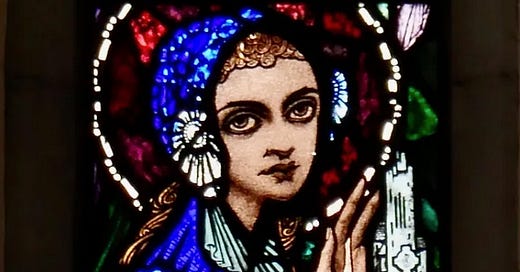
I’ve been spending a lot of time these past few months with St Brigid of Kildare. Last year, my priest asked me to take on the intimidating task of writing an Akathist hymn for her. An Akathist is a long hymn of praise dedicated to a particular saint, the formula for which is long-established, traceable as it is to 6th-century Byzantium. There are not many Akathists to Western saints, given how new the Eastern Orthodox tradition is here, and since St Brigid is one of Ireland’s three patron saints, it seemed about time to give her her own Akathist hymn, to be sung on her patron day - which is today.
I can’t say how well I did at this endeavour, but I like a challenge, and when a saint prods you in this way, it is not right - maybe it is not possible - to refuse. Regardless of the result though, this project meant that I had to go back to the sources for the life of St Brigid, which gave me an interesting insight not only into what the life of this early Irish saint may have involved, but also of how it was seen by others - then and now.
You don’t have to read many lives of early Christian saints, be they in Ireland, Egypt or anywhere else, to notice some themes emerging. These ‘lives’ are not biographies in the modern sense; rather they are stories of spiritual warfare. They are an attempt to demonstrate the holiness and importance of the saint in question, and through them the truth of the Christian faith. Sometimes this spiritual warfare is spoken of in terms of the inner struggle, but more often - overwhelmingly so in the life of St Brigid - they manifest externally as tales of miracles and magic.
Brigid was a Christian nun, Abbess and, interestingly, Bishop (at least technically, if not in practice) who founded a monastery at Kildare in Ireland in the sixth century, and was an influential figure in the Irish Christianity of the time. There are several sources for her life, the most comprehensive of which is the Vita Sanctae Brigitae, written by a monk named Cogitosus around the year 650, about 125 years after her death. The Vita tells of Brigid’s early life: she was, we learn, the symbolically-intriguing daughter of a slave and a king, adopted and raised by a druid, who prophesied her future greatness. A saintly figure from a young age, her love of Christ led her early into the monastic life (she refused several offers of marriage, going so far as to pluck her own eyes out when one suitor told her how beautiful they were) and set out instead on a monastic life.
As a nun and Abbess, Brigid became renowned for giving everything she had (and sometimes things that other people had) to the poor. This was a pattern begun in childhood, when she had given her mother’s entire store of butter to a poor family and her father’s jewel-encrusted sword to a beggar. She once said she would give the whole of the Kingdom of Leinster to the poor if she could. The force of her personality, her love for the weak and the work done by the monastery she founded had her considered a saint in her own lifetime, as did her miracles, of which my favourite is the turning of water into beer: a very northern European version of Jesus’s wedding gift. After her death, the ‘Mary of the Gael’ became the centre of a cult across Ireland and further afield. Her miraculous help with childbirth, her protection of flocks and herds, and the healing power of her wells testified - still, in fact, testify - to her continued presence in the landscape.
That, at any rate, is the Christian version of her life. But there is a neo-pagan version too, which is gaining in popularity as Irish Christianity withers. This has it that St Brigid - if she even existed - was a Christianisation of the pre-Christian ‘Celtic’ goddess Brigid, said to have been the goddess of fire, smithwork and poetry, amongst other things. St Brigid’s Day is, we are told, the same date as the old pre-Christian festival of ‘Imbolc’, which was reworked by the Church as a means of suppressing or appropriating the old religion. Mother goddesses are more fashionable these days than Christian saints, and so it goes with the grain of the times to tell a tale of a female goddess displaced by a male God.
Keep reading with a 7-day free trial
Subscribe to The Abbey of Misrule to keep reading this post and get 7 days of free access to the full post archives.




